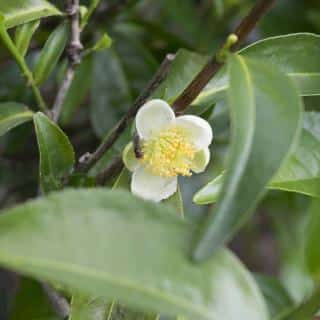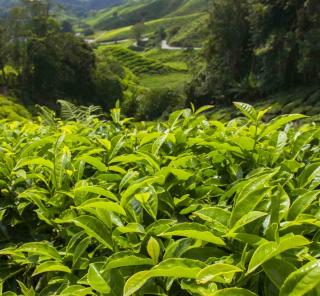

So, in your pocket urban garden, you’ve already grown cherry tomato, radish, strawberry, herbs, and started off your avocado? Next up: the tea tree!
Key facts to remember
Name – Camellia sinensis
Family – Theaceae
Type – Flower shrub
Height – 3 to 9 feet (1 to 3 m)
Exposure – sun and part sun
Soil rather light and well drained
Flowering – November to March
Foliage – evergreen
Camellia sinensis, or tea tree, is a very famous relative of the ornamental Japanese Camellia. Original, and edible, the tea tree grows very well in the ground (as a standalone or part of a hedge) and… in pots!
Its smallish size for a shrub (3-4 to 9-12 feet, or about 1-1.5 to 3-4 meters) makes it a shrub that fits well in urban gardens.
It’s possible to plant a tea tree anytime during the year, apart from during frost spells in winter and high temperature days in summer.
From April to June is a great time to settle it in the ground, but you can also go ahead in September/October. Find a place that is well-protected from wind, either in the shade or in part shade.

The tea tree is cold hardy down to 19-23°F (-5 to -7°C), but it’s better to winterize it in a greenhouse or a lean-in to protect its leaves: they’ll fall off if it freezes or snows.
If your tea tree is growing in a pot, bring it out from May to October. Keep it in the shade and out of the wind.
Tea tree likes well aerated soil that drains well, stays cool, and most importantly, an acidic pH because it’s a heath plant at heart. Give it mulch made from pine tree bark, and water as soon as the surface of the soil is dry. Use rainwater because it hates hard water. Also feel free to mist its leaves on days of hot weather.
It’s perfectly possible to cultivate a tea tree in your own home, in the garden, and harvest its leaves to make your own tea.
In June, and then again from October to December It then is covered in small white flowers with a yellow center, which look magnificent against the elegant, shiny leaves.
These fragrant, evergreen leaves are the basis for brewing tea.
T
Dry the leaves for 24 hours in the shade, and then again in an oven at around 200°F (90°C), with the door open to evacuate moisture. Savor its authentic taste and experiment with growing techniques and drying times to adapt it to your taste over the years!
Take note: you’ll need to gather several pounds of leaves to get a single pound of tea, and a single tea tree won’t let you gather very much of it.
Tea trees are the first step in preparing tea, and how you prepare the leaves after the harvest makes the difference between green tea and black tea. If the leaves are simply dried, you’ll get green tea. Black tea, on the other hand, requires fermenting the leaves beforehand. Rich in both theanine and caffeine, tea is not only savored for its taste, but also for its many medicinal properties and for the health benefits it procures the body.
Claire Lelong-Lehoang